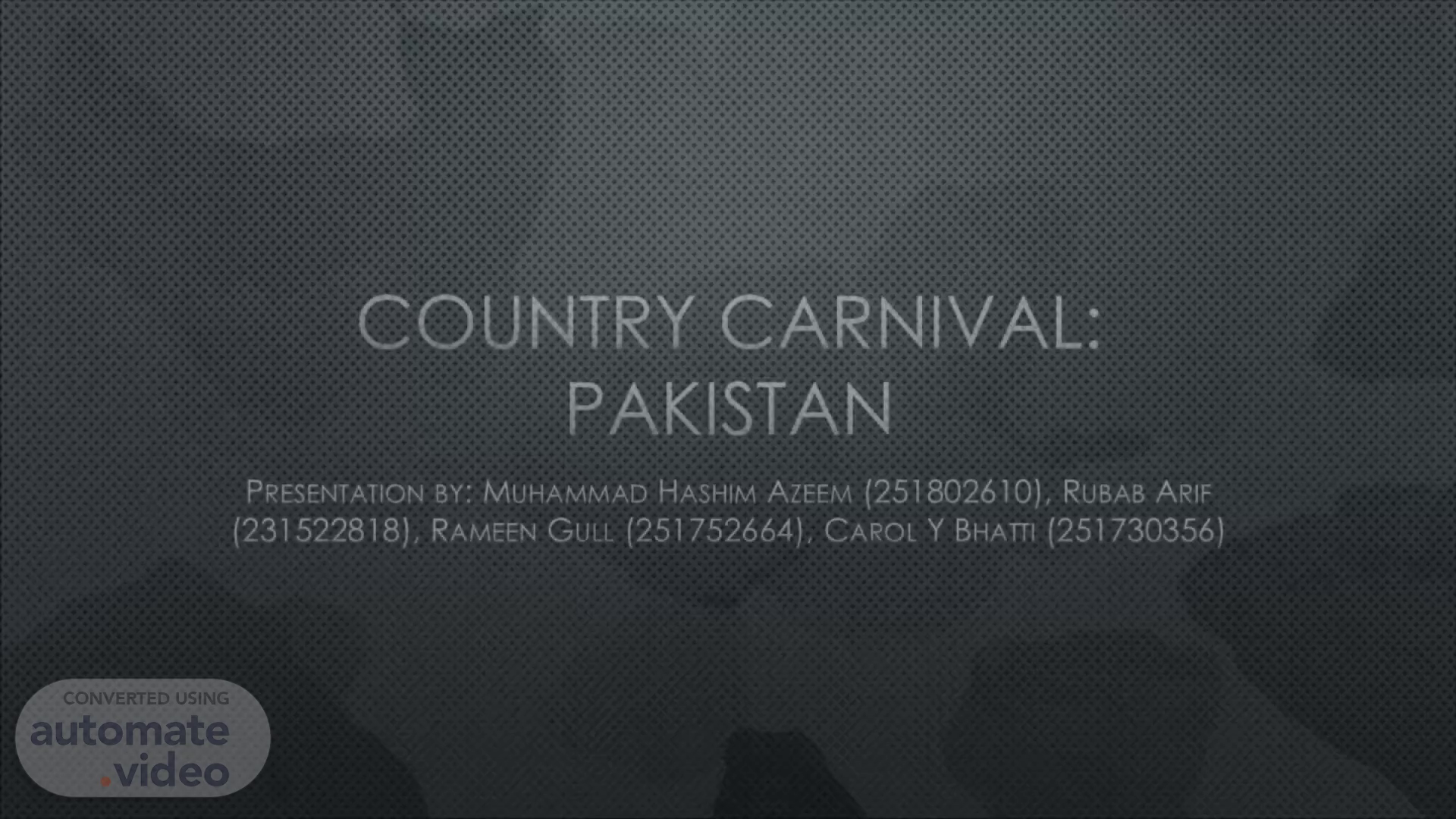
Page 1 (0s)
[Audio] Welcome to our presentation about Country Carnival: Pakistan. We will be sharing with you our research and findings about the vibrant country of Pakistan. From its colorful leaf patterns and economic growth, to its poverty and its education and health sectors, we will be exploring the many facets of this fascinating country. So get ready to embark on an exciting journey and discover the true beauty of Pakistan..
Page 2 (28s)
[Audio] Pakistan is facing some of the most critical challenges, such as instability, gender disparities and rising inequalities with the disastrous impacts of climate change. Poverty is one of the major issues that Pakistanis are dealing with today. A study in 2016 found that 39% of Pakistan's population live below the poverty line. This means that there are roughly 70 million out of 180 million people who are living in poverty. Despite experiencing a decrease in poverty in the 1970s and 1980s, historical data shows an increase in poverty levels since 1990. This is known as the 'poverty pump'. We hope to address this issue by presenting our project 'Country Carnival: Pakistan'..
Page 3 (1m 18s)
[Audio] Pakistan has an alarming poverty rate, with 77.60% of its population living in poverty in 2018, a 1.2% increase from 2015. Going further back in time, the poverty rate in 2013 was 80.40%, a 3.5% decline from 2011. The poverty rate in 2011 was 83.90%, a 1.2% decrease from 2010. These figures highlight the need to tackle poverty in the country..
Page 4 (1m 53s)
[Audio] As shown in the data, over the last 10 years, Bangladesh has seen a higher Gross Domestic Product growth rate than Pakistan. This indicates Bangladesh's strong economic performance. The data is indicative of a trend that has been present over the last decade..
Page 5 (2m 11s)
[Audio] Welcome to Country Carnival: Pakistan! Today we will be looking at the GDP growth rate for Pakistan for the past decade. According to the table, Pakistan's GDP growth rate has had its ups and downs. In 2012, the growth rate was 6.52 percent with a meager 0.06 percent annual change. In 2013, the growth rate dropped 0.51 percent before rising in 2014 with a 0.05 percent rise. In 2016, the growth rate saw the biggest increase with a 0.56 percent increase. By 2020 however, the growth rate was at its lowest at 3.45 percent, with a 4.43 percent decrease. In 2021, the growth rate rose to 6.94 percent, a 3.49 percent increase. When compared to Bangladesh's GDP Growth Rate, the table shows that Bangladesh had a more consistent rate of growth, with the biggest decrease being 3.65 percent in 2019..
Page 6 (3m 22s)
[Audio] Education is essential for the advancement of any nation and nowhere is this more evident than in Pakistan. In spite of poverty and a lack of economic opportunities, the people of Pakistan realize that education is the key to success and a brighter future. Unfortunately, the current proportion of government spending on education is largely spent on recurrent expenses such as staff salaries instead of much-needed upgrades and improvements to the quality of education which includes training, curriculum and monitoring. Thus, it is critical that additional funds are allocated for the improvement of the nation's education sector..
Page 7 (4m 0s)
[Audio] Today, we will be discussing the health sector in Pakistan. In order to address the outbreak of COVID-19 pandemic and make substantial progress on Sustainable Development Goals, the Government of Pakistan has taken necessary steps to strengthen its health sector. This includes improved public sector health facilities and increased number of Basic Health Units and Rural Health Clinics with essential services. The Lady Health Workers Program has also been revitalized through training, support and a revised service structure. As a result, Pakistan's Infant Mortality Rate and Neonatal Mortality Rate have decreased, while the percentage of births attended by skilled health personnel has increased. The Maternal Mortality Ratio has also fallen significantly from 2006-2019..
Page 8 (4m 51s)
[Audio] Slide 8 shows us the statistical data on health and education in Pakistan. It's striking to see how much progress the country has made in such a short amount of time. We see that the literacy rate has improved since the 2000s and has steadily been increasing. Also, public health efforts have resulted in a decrease in infant mortality and an increase in life expectancy over the past decades..
Page 9 (5m 18s)
[Audio] The major exports of Pakistan contribute the most to its economy. Textile products generate about 4 billion USD dollars, with cotton following closely behind at about 3 billion, and Apparel Kits also at around 3 billion. Other important exports include cereals with 2 billion, seafood with 40 million, and leather products with 60 million..
Page 10 (5m 58s)
[Audio] Pakistan is one of the leading countries in imports. Oil and mineral fuels top the list with a whopping 14 billion US dollars. Industrial machinery and electrical engineering follow closely with 4 billion US dollars each. Iron and steel, organic chemicals, and plastic make up the remaining 3, 3, and 2 billion US dollars respectively..
Page 11 (6m 27s)
[Audio] Pakistan is a country with a long history and culture that has been through both positive and negative experiences. From inflation and trade deficits to impressive energy production and infrastructure developments, the country's economy has faced many challenges. Despite these difficulties, the nation has made progress and taken steps towards achieving sustainable growth. The government has implemented economic reforms and received international financial assistance to help aid their efforts. However, there is still much to be done in order to ensure that the country will continue to make strides towards a healthier economy. We hope that this presentation has provided you with a glimpse into Pakistan's economic situation and future potential. Thank you for your time and interest..